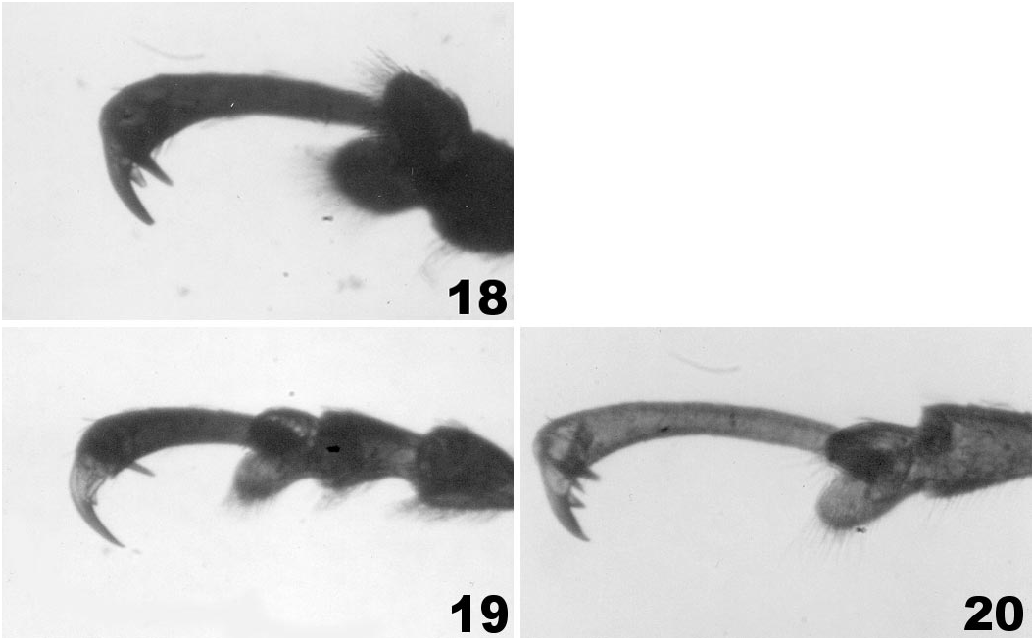Magdalinops vittipennis Dietz, 1891
|
publication ID |
https://doi.org/10.1649/0010-065X(2002)056[0107:ROTWGM]2.0.CO;2 |
|
DOI |
https://doi.org/10.5281/zenodo.15699554 |
|
persistent identifier |
https://treatment.plazi.org/id/03CF8799-FFE5-C758-91F7-14B5617DA216 |
|
treatment provided by |
Carolina |
|
scientific name |
Magdalinops vittipennis Dietz |
| status |
|
Magdalinops vittipennis Dietz View in CoL
Figs. 1, 2 View Figs , 11 View Figs , 15 View Figs , 18 View Figs , 21 View Figs
Magdalinops vittipennis Dietz 1891:184 .
Lectotype (here designated). United States. California. [Cal.] [Type 1945/ W. G. Dietz Coll./ Magdalinops vittipennis Dietz ] ( female, MCZC). Paralectotype. [Cal.] [ Magdalinops /vittipennis/Dietz] [Type 8140/ Magdalinops /vittipennis/ W. G. Dietz] (♂, MCZC). Dietz (1891:184) stated that M. vittipennis was described from two females and one male.
Description. Body ( Figs. 1–2 View Figs ): elongate, cylindrical, parallelsided in dorsal view; length 3.2–5.4 mm; width 1.2–2.1 mm. Integument black, narrowly exposed on dorsolateral portions of pronotum and on evennumbered elytral interstriae, otherwise concealed beneath cinereous to fulvoferruginous scales. Head: vertex, frons and venter with dense, imbricated scales; eyes small, round. Rostrum: ( Fig. 1 View Figs ). slender, slightly, evenly curved from base to apex; proximal portion rugosepunctate, with dense, cinereous scales; feebly carinate dorsomedially; lateral rostral groove broad, punctulate, with elongate cinereous scales; dorsal margin of lateral rostral groove carinate, posteroventral margin delimited by transverse carina extending from eye to lower margin of rostrum; distal portion rugulose, punctate, glabrous, expanded at apex in dorsal view. Antennae: funicular segments with broad, cinereous scales; club ovoid, compact, evenly tapered from middle to acute apex; basal segment glabrous, shining, long, ca. 0.50 X as long as club. Prothorax: pronotum densely, coarsely punctate, with narrow middorsal carina; elongate, imbricated scales predominant laterally and in broad middorsal vitta; sparser, narrower, cinereous scales predominant dorsolaterally; mesocoxae separated by distance ca. 0.1 X width of one mesocoxa. Elytra : subparallelsided in dorsal view, flattened on disc, broadly rounded posteriorly in lateral view; striae distinctly impressed, each puncture bearing one minute scale; interstriae flattened, subequal in width; evennumbered interstriae with elongate, broadly imbricated, cinereous scales and with irregular median row of sparse, narrower, darker scales; oddnumbered interstriae with narrower, sparser cinereous scales; sutural interstriae not prominent. Scutellum : with dense cretaceous scales. Abdomen: sterna with dense, cinereous scales. Legs: profemur stout, with one small ventral tooth; metafemur with one obsolescent ventral tooth ( Fig. 11 View Figs ); protibia with welldeveloped innermarginal prominence in basal 1/3, inner margin concave in apical 1/3, with distinct, acute, preapical prominence; protibial uncus large, curved, acute; metatibia with outer margin slightly curved, especially in basal 2/3, inner margin prominent in basal 1/3, broadly concave in apical 2/3, with distinct preapical convexity ( Fig. 11 View Figs ); metatibial mucro narrow, straight, oblique, acute ( Fig. 11 View Figs ); 5th tarsal segment 2.5 X longer than 3rd segment ( Fig. 18 View Figs ); tarsal claw with long, slender, acute tooth arising from inner margin slightly distad of base ( Figs. 15 View Figs , 18 View Figs ). Male Genitalia: ( Fig. 21 View Figs ). median lobe of aedeagus slightly constricted subapically, evenly, gradually narrowed to rounded apex in dorsal view; endophallus unarmed.
Specimens Examined. In addition to the lectotype and paralectotype from in California, 29 specimens of M. vittipennis from the following localities were examined. United States. California. Alpine Co.: Markleeville ( 1, CDAE) . Inyo Co.: Big Pine ( 1, CMNC) ; Independence ( 1, USNM) ; Lone Pine ( 1, CISC) ; 2 mi. NE Lone Pine ( 1, CISC) ; Owens Valley ( 1, CISC) . Kern Co.: Frazier Park (‘‘ Chrysothamnus , ’’ 2, CDAE; 4,800 –5,000 ', 1, CMNC) GoogleMaps ; Havilah (3,000 ', 1, CISC) ; 5 mi. S Monolith (‘‘ Chrysothamnus , ’’ 2, CISC) ; Walker Pass ( 1, USNM) . San Bernardino Co.: Victorville ( 2, USNM) ; 2 mi. NW Yucca Valley (4,100 ', 1, CHAH) . San Diego Co.: ( 9, USNM) ; Oak Grove ( 2, UCDC) . Santa Barbara Co.: 8 mi. W New Cuyama ( 1, TAMU) . Ventura Co.: Cayama Valley ( 1, CDAE) .
Plant Associations. Label data indicate that adults of M. vittipennis have been collected on Chrysothamnus (Asteraceae) .
Remarks. In some specimens of M. vittipennis the scales are cinereous throughout and only slightly narrower on the oddnumbered elytral interstriae. In others, a greater or lesser proportion of the scales on the pronotum and oddnumbered interstriae are narrower and fulvescent in color, giving the elytra a more distinctly vittate appearance.
No known copyright restrictions apply. See Agosti, D., Egloff, W., 2009. Taxonomic information exchange and copyright: the Plazi approach. BMC Research Notes 2009, 2:53 for further explanation.
|
Kingdom |
|
|
Phylum |
|
|
Class |
|
|
Order |
|
|
Family |
|
|
Genus |
Magdalinops vittipennis Dietz
| Clark, Wayne E. & Burke, Horace R. 2002 |
Magdalinops vittipennis
| Dietz 1891: 184 |





